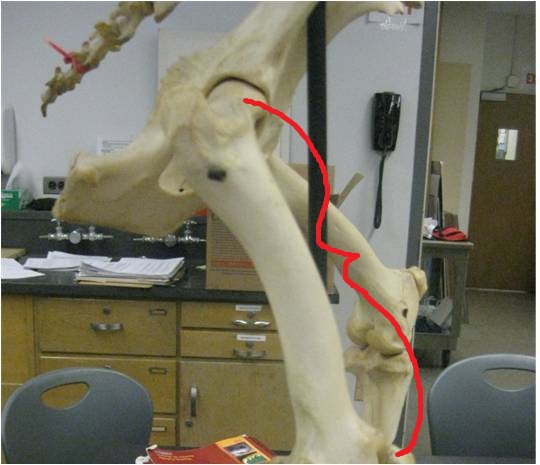AHS 202l Hindlimb Skeleton

ANSWER IN all lowercase PLEASE :) � the talus isn't in here since I didn't have a good picture of it. Its located under the hock.
�
Questions and Answers
- 1.
- 2.
- 3.
right
Explanation
The correct answer is "right femoral head." This suggests that the question is asking for the location or identification of a specific anatomical structure, specifically the femoral head on the right side of the body.Rate this question:
- 4.
right
- 5.
right. name them both.
Explanation
The correct answer is "right lateral and medial condyles, right medial and lateral condyles." This answer is correct because it correctly identifies both the lateral and medial condyles on the right side. The order in which they are listed (lateral and medial or medial and lateral) does not affect the accuracy of the answer.Rate this question:
- 6.
right. name them both
Explanation
The correct answer is "right lateral and medial epicondyles" and "right medial and lateral epicondyles". These are the names of the two anatomical structures being referred to in the question. The terms "lateral" and "medial" describe the position of the epicondyles in relation to the midline of the body, while "right" indicates the specific side being referred to. Therefore, both options correctly identify the epicondyles on the right side of the body using different word order.Rate this question:
- 7.
left.
- 8.
left.
- 9.
left.
- 10.
left
Explanation
The given correct answer is "left tibia". This suggests that the question is asking for the specific body part that is being referred to. In this case, it is the left tibia, which is one of the bones in the lower leg.Rate this question:
- 11.
left.
- 12.
left
- 13.
right. name both of them
Explanation
The correct answer is "right lateral and medial malleolus, right medial and lateral malleolus." Both the lateral and medial malleolus are bony prominences found on the ankle. The lateral malleolus is located on the outer side of the ankle, while the medial malleolus is on the inner side. The question is asking for both the correct names for these structures, which are "right lateral and medial malleolus" and "right medial and lateral malleolus."Rate this question:
- 14.
right.
- 15.
right. the entire joint as a whole.
Explanation
The correct answer is "right hock." This suggests that the question is likely asking for the specific location or part of an animal's body. In this case, the right hock refers to a joint in the animal's leg.Rate this question:
- 16.
right
- 17.
left
- 18.
left.
- 19.Explanation
The left obturator foramen is the correct answer because it is a specific anatomical structure located in the pelvis. The obturator foramen is a large opening in the hip bone that allows for the passage of nerves and blood vessels. It is located on both sides of the pelvis, but in this case, the question specifies the left side. Therefore, the left obturator foramen is the correct answer.Rate this question:
- 20.
the wing
- 21.
inner bone of join
Explanation
The right acetabulum is the correct answer because it is the socket of the hip joint that connects with the head of the femur. It is a concave surface that forms part of the pelvis and provides stability and support to the hip joint. The inner bone of the joint refers to the acetabulum, and in this case, specifically the right acetabulum.Rate this question:
- 22.Explanation
The right greater trochanter is the correct answer because it is a specific anatomical structure located on the right side of the body. The greater trochanter is a bony prominence on the femur that serves as a site of attachment for various muscles, including the gluteus medius and gluteus minimus. It is easily identifiable and is an important landmark for orthopedic evaluations and surgical procedures involving the hip joint.Rate this question:
- 23.
- 24.Explanation
The pelvic cavity is a hollow space in the lower part of the abdomen, surrounded by the pelvic bones. It contains various organs including the reproductive organs, urinary bladder, and part of the large intestine. This cavity provides protection and support for these organs, allowing them to function properly. Additionally, it also plays a role in childbirth by providing enough space for the baby to pass through the birth canal.Rate this question:
- 25.
- 26.
- 27.
- 28.
right
Explanation
The given answer "right tibiotarsal joint" is correct because it accurately identifies the specific joint being referred to. The term "tibiotarsal joint" refers to the joint between the tibia (shinbone) and the tarsal bones in the foot. The use of the word "right" indicates that the joint being referred to is on the right side of the body. Therefore, the answer correctly identifies the specific joint mentioned.Rate this question:
- 29.
right
- 30.
right
Explanation
The given correct answer is "right tarsometatarsal joint". This suggests that the question is asking for a specific joint in the right foot known as the tarsometatarsal joint. This joint is located between the tarsal bones (bones in the foot) and the metatarsal bones (bones in the midfoot). It is responsible for allowing movement and stability in the foot during activities such as walking and running.Rate this question:
Quiz Review Timeline +
Our quizzes are rigorously reviewed, monitored and continuously updated by our expert board to maintain accuracy, relevance, and timeliness.
-
Current Version
-
Mar 17, 2023Quiz Edited by
ProProfs Editorial Team -
Apr 12, 2011Quiz Created by
Norikker
 Back to top
Back to top















.jpg)












.jpg)

